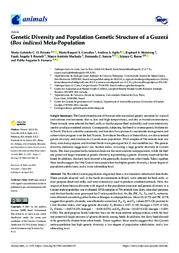Genetic diversity and population genetic structure of a Guzerá (Bos indicus) meta-population.
Genetic diversity and population genetic structure of a Guzerá (Bos indicus) meta-population.
Author(s): PEIXOTO, M. G. C. D.; CARVALHO, M. R. S.; EGITO, A. A. do; STEINBERG, R. S.; BRUNELI, F. A. T.; MACHADO, M. A.; SANTOS, F. C.; ROSSE, I. C.; FONSECA, P. A. S.
Summary: The Brazilian Guzerá population originated from a few founders introduced from India. These animals adapted well to the harsh environments in Brazil, were selected for beef, milk, or dual-purpose (beef and milk), and were extensively used to produce crossbred animals. Here, the impact of these historical events with regard to the population structure and genetic diversity in a Guzerá meta-population was evaluated. DNA samples of 744 animals (one dairy, nine dual-purpose, and five beef herds) were genotyped for 21 microsatellite loci. Ho, He, PIC, Fis, Fit, and Fst estimates were obtained considering either farms or lineages as subpopulations. Mean Ho (0.73) and PIC (0.75) suggest that genetic diversity was efficiently conserved. Fit, Fis and Fst values (95% CI) pointed to a low fixation index, and large genetic diversity: Fit (Farms = 0.021?0.100; lineages = 0.021?0.100), Fis (Farms = ?0.007?0.076; lineages = ��0.014?0.070), and Fst (Farms = 0.0237?0.032; lineages = 0.029? 0.038). The dual-purpose herds/selection lines are the most uniform subpopulation, while the beef one preserved larger amounts of genetic diversity among herds. In addition, the dairy herd showed to be genetically distant from other herds. Taken together, these results suggest that this Guzerá meta-population has high genetic diversity, a low degree of population subdivision, and a low inbreeding level.
Publication year: 2021
Types of publication: Journal article
Unit: Embrapa Dairy Cattle
Observation
Some of Embrapa's publications are published as ePub files. To read them, use or download one of the following free software options to your computer or mobile device. Android: Google Play Books; IOS: iBooks; Windows and Linux: Calibre.
Access other publications
Access the Agricultural Research Database (BDPA) to consult Embrapa's full library collection and records.
Visit Embrapa Bookstore to purchase books and other publications sold by Embrapa.

